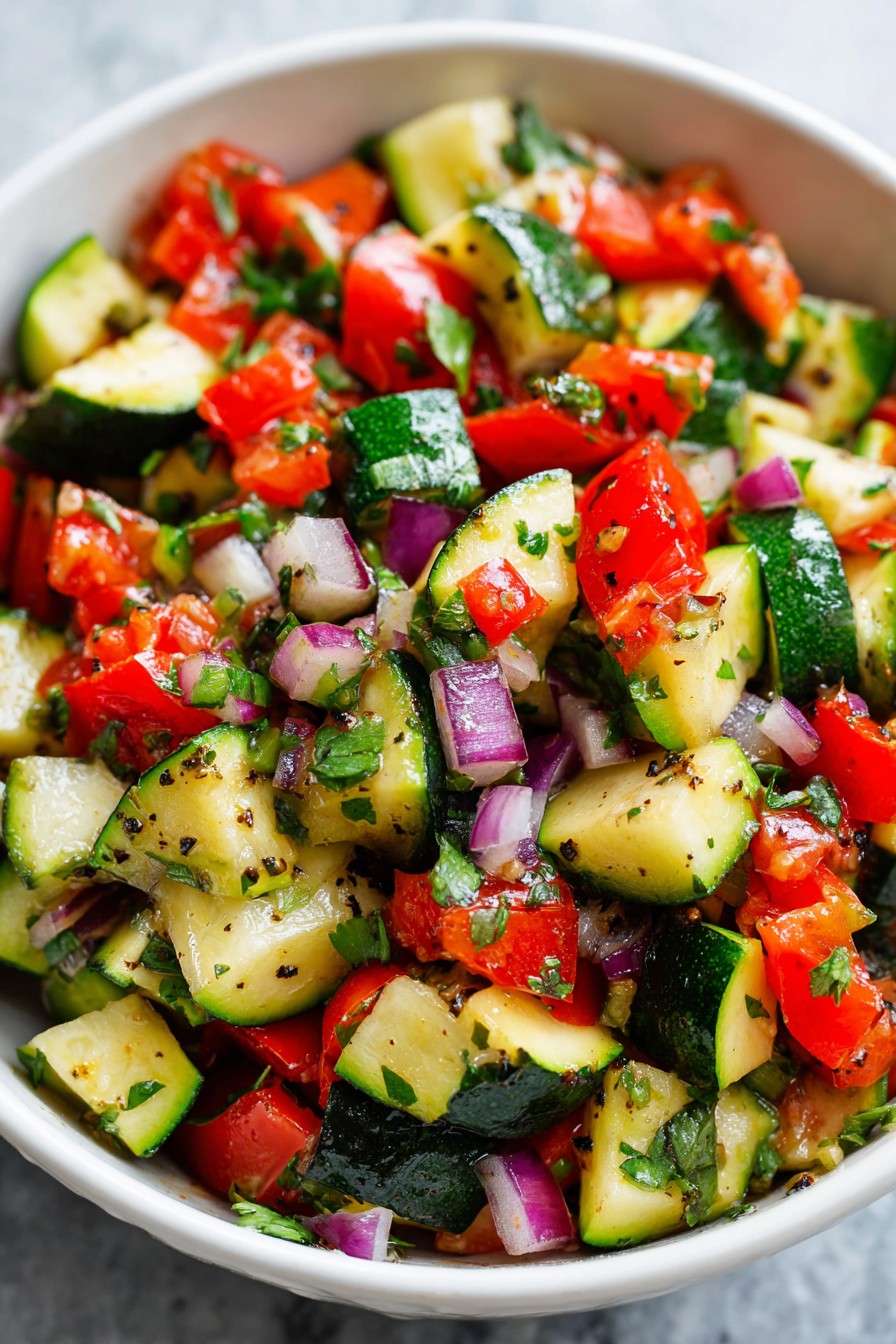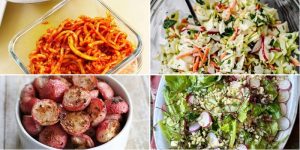Seasonal zucchini transforms ordinary salsa into a nutrient-packed powerhouse that celebrates garden-fresh flavors while reducing food waste. Surprisingly versatile and incredibly easy to prepare, this vibrant salsa offers a lower-calorie alternative to traditional versions while delivering exceptional texture and flavor complexity that will become your new go-to condiment.
Why This Recipe Works
- The combination of raw and roasted vegetables creates dynamic texture contrasts and layered flavor profiles, with roasted zucchini developing caramelized sweetness while raw ingredients maintain bright, fresh notes that balance the overall composition perfectly.
- Strategic ingredient ratios ensure optimal moisture control, preventing the watery texture that often plagues zucchini dishes while allowing the natural vegetable juices to enhance rather than dilute the salsa’s consistency and flavor intensity.
- Nutritional optimization occurs through careful preparation methods that preserve heat-sensitive vitamins in raw components while developing beneficial antioxidants through controlled roasting, creating a health-supportive condiment that doesn’t sacrifice taste for wellness benefits.
- Versatile serving applications make this salsa equally suitable as a dip, topping, or ingredient in other dishes, with its balanced acidity and vegetable-forward profile complementing proteins, grains, and snacks without overwhelming other flavors in your meal composition.
Ingredients
- 2 medium zucchinis (approximately 1 pound total), diced into 1/4-inch pieces
- 1 large red onion, finely chopped
- 3 medium tomatoes, seeded and diced
- 2 jalapeño peppers, minced (seeds removed for milder heat)
- 1/4 cup fresh lime juice (from 2-3 limes)
- 1/3 cup chopped fresh cilantro
- 2 cloves garlic, minced
- 1 teaspoon ground cumin
- 1/2 teaspoon smoked paprika
- 1 tablespoon olive oil
- 1 teaspoon salt
- 1/2 teaspoon black pepper
Equipment Needed
- Cutting board and sharp chef’s knife
- Large mixing bowl
- Baking sheet
- Parchment paper
- Measuring cups and spoons
- Citrus juicer or reamer
- Rubber spatula
Instructions

Prepare and Roast the Zucchini
Begin by preheating your oven to 425°F and lining a standard baking sheet with parchment paper to prevent sticking and ensure easy cleanup. Dice two medium zucchinis into uniform 1/4-inch pieces, which promotes even roasting and optimal texture development. In a large mixing bowl, toss the zucchini pieces with one tablespoon of olive oil, ensuring each piece receives a light, even coating that will facilitate caramelization without making the vegetables greasy. Spread the oiled zucchini in a single layer on your prepared baking sheet, being careful not to overcrowd the pan, which would cause steaming rather than proper roasting. Roast for 15-18 minutes, checking at the 12-minute mark for doneness indicators including golden-brown edges, slightly shriveled appearance, and tender-but-not-mushy texture when pierced with a fork. This roasting process concentrates the zucchini’s natural sugars while reducing excess moisture that could water down your final salsa. Remove from oven and allow to cool completely to room temperature, which typically takes 20-25 minutes, before proceeding to the next preparation step.
Chop Fresh Ingredients
While the zucchini cools, meticulously prepare your fresh vegetables to ensure consistent texture and optimal flavor distribution throughout the salsa. Finely chop one large red onion, aiming for pieces approximately 1/8-inch in size, which provides substantial texture without overwhelming other ingredients. Seed and dice three medium tomatoes, discarding the watery seed pockets and gelatinous interior to prevent excess liquid from compromising your salsa’s consistency. For optimal heat control, slice two jalapeño peppers lengthwise and use a small spoon to scrape out the seeds and white membranes, which contain most of the capsaicin, then mince the remaining flesh finely. Mince two cloves of garlic until they reach a paste-like consistency, which distributes their flavor more evenly than larger pieces would. Chop 1/3 cup of fresh cilantro leaves, avoiding the thicker stems which can impart a bitter flavor, and juice 2-3 limes until you have 1/4 cup of fresh lime juice. This careful preparation ensures each ingredient contributes optimally to the final flavor profile and texture balance.
Combine and Season the Salsa
Transfer your completely cooled roasted zucchini to a large mixing bowl, being careful to include any caramelized bits that may have stuck to the parchment paper, as these contain concentrated flavor compounds. Add the prepared fresh ingredients including the chopped red onion, diced tomatoes, minced jalapeño, garlic paste, and chopped cilantro, distributing them evenly throughout the bowl. Sprinkle one teaspoon of salt, 1/2 teaspoon of black pepper, one teaspoon of ground cumin, and 1/2 teaspoon of smoked paprika over the vegetable mixture, ensuring the spices are evenly distributed across the surface before mixing. Pour the 1/4 cup of fresh lime juice over everything, using the acidity to both brighten flavors and help preserve the fresh ingredients. Using a rubber spatula, gently fold all ingredients together with a lifting motion rather than stirring aggressively, which preserves the distinct textures of each component while ensuring thorough integration of seasonings.
Rest for Flavor Development
Cover the mixing bowl tightly with plastic wrap or transfer the salsa to an airtight container, ensuring no air pockets remain that could accelerate oxidation of the fresh ingredients. Refrigerate the salsa for a minimum of two hours, though ideally four to six hours for optimal flavor development, as this resting period allows the salt to draw out natural vegetable juices and the acids to gently break down cell structures. During this time, the flavors will meld beautifully, with the roasted zucchini absorbing the bright lime and spice notes while the raw vegetables maintain their crisp freshness. The resting period also allows the smoked paprika and cumin to fully hydrate and distribute their warm, earthy flavors throughout the mixture. This crucial step transforms individual ingredients into a cohesive, complex condiment where no single element dominates but all work in harmonious balance.
Final Adjustments and Serving
After the resting period, remove your salsa from refrigeration and give it one final gentle stir to redistribute any settled juices or seasonings. Taste carefully and adjust seasoning if necessary, considering whether additional salt, lime juice, or spices would enhance the flavor balance to your personal preference. For serving, transfer to an attractive bowl and consider garnishing with a few whole cilantro leaves or a light dusting of smoked paprika for visual appeal. Serve immediately with your chosen accompaniments, or return to refrigeration until needed, remembering that the flavors will continue to develop and improve for up to 24 hours after initial preparation. The final salsa should exhibit a perfect balance between the sweet, caramelized notes from the roasted zucchini and the bright, fresh flavors from the raw vegetables, with just enough heat and acidity to keep each bite interesting.
Tips and Tricks
Selecting the right zucchini significantly impacts your final results—choose firm, medium-sized specimens with bright green, unblemished skin and a diameter of approximately 1.5 to 2 inches, as oversized zucchini tend to be more watery and less flavorful. For optimal texture control, consider salting your diced zucchini lightly and letting it drain in a colander for 20 minutes before roasting, which removes excess moisture that could make your salsa watery. When roasting, position your baking sheet in the upper third of the oven where heat circulation is typically best, and consider rotating the pan halfway through cooking if your oven has hot spots. For those sensitive to spice, remember that jalapeño heat levels vary dramatically—taste a tiny piece of your specific peppers before adding to gauge their intensity, and consider starting with one pepper then adding more if needed. If you prefer a smoother salsa texture, you can pulse half the mixture in a food processor for just 2-3 seconds before combining with the remaining chunky portion. Storage considerations are important—this salsa maintains optimal texture and flavor for 3-4 days in airtight refrigeration, but avoid freezing as the high water content in vegetables creates undesirable texture changes upon thawing. For meal preparation efficiency, you can roast the zucchini up to two days in advance and store separately in refrigeration, then combine with fresh ingredients when ready to serve. If your salsa appears too watery after resting, simply drain off excess liquid or serve with a slotted spoon, reserving the flavorful juice for marinades or salad dressings. For maximum nutritional benefit, keep the zucchini skins intact during preparation as they contain valuable fiber and antioxidants that support digestive health and reduce inflammation.
Recipe Variations
- For a tropical twist, replace one zucchini with one cup of diced pineapple or mango, adding them raw to the final mixture to maintain their bright, sweet notes that contrast beautifully with the spicy and savory elements. The natural enzymes in tropical fruits also help tenderize the other vegetables slightly while adding vitamin C and digestive benefits.
- Create a protein-packed version by adding one cup of cooked black beans and one cup of cooked corn kernels during the final mixing stage, transforming your salsa into a substantial side dish or vegetarian main course. The additional fiber and plant-based protein make this variation particularly satisfying while maintaining the fresh, vibrant character of the original recipe.
- For Mediterranean-inspired flavors, substitute the cumin and smoked paprika with two teaspoons of dried oregano and one teaspoon of lemon zest, while replacing the cilantro with fresh parsley or basil. Add 1/4 cup of crumbled feta cheese and two tablespoons of chopped kalamata olives just before serving for salty, briny notes that complement the zucchini beautifully.
- Spice enthusiasts can intensify the heat by including the jalapeño seeds or adding one finely minced serrano pepper, plus 1/4 teaspoon of cayenne pepper to the spice mixture. For smoky depth, replace one zucchini with one roasted poblano pepper, which provides complex flavor without overwhelming heat, creating a more layered spicy experience.
- For low-carb or keto adaptations, increase the zucchini to three medium specimens and reduce the tomatoes to one, adding 1/2 cup of finely diced cucumber and 1/4 cup of chopped radishes for additional crunch and freshness without significantly increasing carbohydrate content. Adjust seasonings accordingly to balance the altered vegetable ratios.
Frequently Asked Questions
Can I use yellow squash instead of zucchini in this recipe?
Absolutely, yellow summer squash makes an excellent substitute for zucchini in this salsa recipe, offering nearly identical texture and moisture content with a slightly sweeter, more buttery flavor profile. The preparation method remains exactly the same—dice into 1/4-inch pieces, roast at 425°F until tender with golden edges, and combine with the other ingredients as directed. You might notice a subtle color difference in your final salsa, with the yellow squash creating a brighter, sunnier appearance that’s equally appealing. Nutritionally, yellow squash provides similar benefits including good amounts of vitamin C, manganese, and magnesium, though zucchini typically contains slightly higher levels of vitamin A. For the most visually striking result, consider using a combination of both zucchini and yellow squash to create a multicolored salsa that showcases seasonal abundance.
How can I make this salsa less watery?
Several techniques can help minimize excess liquid in your zucchini salsa, starting with proper vegetable preparation. Salting the diced zucchini before roasting draws out significant moisture—simply toss with 1/2 teaspoon of salt, let rest in a colander for 20-30 minutes, then pat dry before roasting. When preparing tomatoes, be thorough about removing the gelatinous seed pockets and juicy interior, using only the firm flesh for your salsa. If your finished salsa still seems too watery after resting, drain it through a fine-mesh strainer for 5-10 minutes before serving, reserving the flavorful liquid for other uses like salad dressings or marinades. Another effective approach involves increasing the ratio of roasted to raw vegetables, as the roasting process evaporates much of the natural moisture content while concentrating flavors.
Is this salsa suitable for canning or long-term preservation?
This particular zucchini salsa recipe is not recommended for traditional canning methods due to several safety concerns, primarily the combination of low-acid vegetables (zucchini, onions) with borderline acidity from tomatoes and lime juice. The pH level likely falls outside the safe range for water bath canning, creating potential risks for bacterial growth including botulism. For shorter-term preservation, proper refrigeration maintains quality for 3-4 days, while freezing—though possible—significantly alters the texture of the vegetables, resulting in a softer, more watery consistency upon thawing. If you wish to preserve garden abundance, consider making a cooked version specifically formulated for canning with tested proportions of acid (usually vinegar or bottled lemon juice) to ensure food safety. Alternatively, you can freeze roasted zucchini separately and combine with fresh ingredients when ready to serve.
What are the nutritional benefits of zucchini salsa?
Zucchini salsa delivers substantial nutritional advantages, starting with exceptionally low calorie density—approximately 25-30 calories per half-cup serving—making it an ideal choice for weight management or volume eating strategies. Zucchini itself provides valuable amounts of vitamin C, which supports immune function and collagen production, along with manganese essential for bone health and metabolic processes. The combination of raw and roasted vegetables offers both water-soluble vitamins from fresh ingredients and fat-soluble antioxidants enhanced through cooking, creating a broader spectrum of available nutrients. The capsaicin in jalapeños may provide metabolic benefits and anti-inflammatory properties, while garlic contains allicin compounds with potential cardiovascular advantages. Together, these ingredients create a nutrient-dense condiment that contributes to daily vegetable intake while providing hydration, fiber for digestive health, and antioxidants that combat oxidative stress.
Summary
This innovative zucchini salsa transforms summer abundance into a nutrient-packed condiment balancing roasted depth with fresh brightness. The strategic combination of preparation methods creates complex flavors and textures while maximizing nutritional benefits from both raw and cooked vegetables. Versatile enough for various dietary preferences and endlessly adaptable to personal taste, this recipe represents seasonal eating at its most delicious and practical.
Zucchini Salsa Recipe
5
servings25
minutes18
minutesIngredients
Instructions
- 1 Preheat oven to 425°F and line baking sheet with parchment paper
- 2 Toss diced zucchini with olive oil and roast for 15-18 minutes until golden-edged and tender
- 3 Cool zucchini completely while preparing remaining fresh ingredients
- 4 Combine roasted zucchini with chopped onion, tomatoes, jalapeño, garlic, cilantro, spices, and lime juice
- 5 Gently fold everything together, cover, and refrigerate for at least 2 hours before serving
- 6 Adjust seasonings to taste and serve chilled or at room temperature



